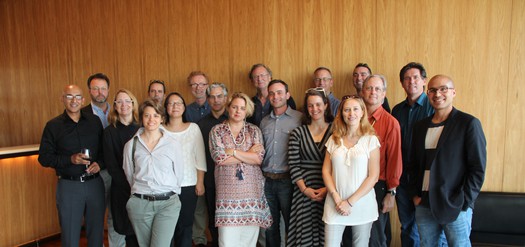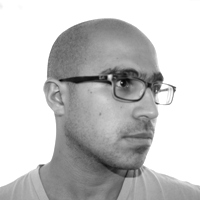
Symposium Participants, Yale University, 2012
The Winterhouse Third Symposium on Design Education and Social Change was held at Yale University, August 19-21, 2012. Thought leaders from various disciplines (design, engineering, architecture and management) and from across the country convened to share ideas about the future of design education for social impact. Most of the participants had attended a previous Winterhouse symposium, but there were new participants from Yale University, Stanford University, Parsons School for Design and Northwestern University.
While many topics of interest from previous symposia were revisited and explored further, the abiding theme of this year’s symposium was “action.” The participants placed a significant emphasis on translating their progress from previous years into concrete initiatives that will move the field of social innovation forward. Themes that were explored in the first and second symposia included:
• Defining social design
• Charting new academic social-design programs and initiatives
• Forming partnerships between educational institutions, foundations and NGOs
• Establishing metrics for the efficacy of social design programs
• Navigating educational requirements and goals while contributing to social welfare
• Exploiting media platforms for disseminating information about social design
• Outlining opportunities for meeting and collaboration
• New ideas and proposals for collective action
1. Innovating inside the Institution
An early session at this year’s symposium explored the challenges and opportunities within educational institutions as they develop social design and social innovation programs. From tenure-review criteria to campus geography, universities provide many incentives to work within established norms. For design and social innovation education to reach its potential and harness resources across entire universities, how can we overcome some of the barriers to collaboration and create new incentives for innovation?
Banny Banerjee, Founder and Director of ChangeLabs at the Stanford d.school, articulated the distinctions between interdisciplinary, multidisciplinary and transdisciplinary education. Transdisciplinary education is both the most valuable and the hardest to achieve. Tom Fisher, Professor and Dean of the College of Design at the University of Minnesota, added that while academic research is frequently transdisciplinary, teaching is virtually always circumscribed by the particular department offering the course.
Despite the challenges, many participants have found ways of driving organizational change, sometimes in ways as direct as using the right language. Marcia Lausen, Director of the School of Art and Design at the University of Illinois at Chicago, shared the term “disciplinary exchange” to help other departments understand collaboration around curricular initiatives. Allan Chochinov, Chair of the School of Visual Arts MFA in Products of Design, posited that designers are the “connective tissue” of an institution because they are conversant with the needs and language of so many different stakeholders.
The challenge of collaboration sometimes stems from the physical landscape of an institution. Tom Fisher remarked that “campuses are part of the inhibition; they often keep us intellectually and geographically separate.” Two blocks from the location of the Symposium, a new facility for Yale University’s Center for Engineering, Innovation and Design is soon to open. The building is located centrally on campus along a busy thoroughfare (and close the the business and forestry schools). Nevertheless, as Wendy Ju, Assistant Professor at the California College of the Arts, pointed out, “dedicated spaces are not a panacea.”
Overall, participants agreed that students can be significant drivers of change within university settings. However, student efforts can be stymied by the fact that students graduate too quickly to execute on long-term goals. While administrators and tenured faculty often remain with the same institution for decades, students must develop better processes for passing down institutional knowledge. As David Mohney, Dean Emeritus and Professor of Architecture at the University of Kentucky College of Design, pointed out, the University of Bologna, the oldest in the world, has at times in its history been run by equal numbers of faculty and students. The idea of students and faculty co-creating the future of design and social innovation education was compelling to many participants.
2. Engaging with the World
Universities have long been a hotbed for innovation. When companies like Google and Facebook are being developed in campus settings, what might the ceiling be for social enterprises? In recent years, outstanding examples of student-led social innovation have begun to take root. Warby Parker, founded by Wharton MBAs, employs a “buy one, give one” model that provides a pair of eyeglasses to someone in need for every pair purchased. D.Light Design, founded by a Stanford MBA, provides high-quality, affordable solar lanterns to over seven million people in the developing world. To support growing interest among students, new educational institutions dedicated to social innovation, such as Knowmads and KaosPilots, are also emerging.
Educational institutions play an important role in spreading ideas that support social innovation. Scott Boylston, Program Coordinator of Design for Sustainability at the Savannah College of Art and Design, points to the rise of benefit corporations as an important development in the legal landscape that should be more widely known. Lara Penin, Assistant Professor at Parsons School for Design, shared her experience with Design for Social Innovation towards Sustainability (DESIS), which describes itself as “a network of design labs, based in design schools and design-oriented universities, actively involved in promoting and supporting sustainable change.”
Student entrepreneurs with an interest in social impact have a growing number of options to pursue funding. Liz Gerber, Assistant Professor at Northwestern University and Founder of Design for America, pointed to crowdfunding as a potential avenue for low-cost experimentation in the field. The rise of startup incubators and accelerators like Y Combinator and Techstars have spurred dozens of similar programs across the country, many specializing in areas such as health care and education. The Unreasonable Institute is a notable accelerator focused solely on social ventures. Universities are also providing support for fledgling student ventures through initiatives like the Harvard Innovation Lab and the Yale Entrepreneurial Institute. By contrast, the funding ecosystem for research and projects in social innovation may be less developed. As Bannerjee described it, “there is no National Science Foundation for our kind of work.” The White House Office of Social Innovation and Civic Participation is a welcome addition to the landscape, but there were concerns that its portfolio is still limited in scope.
Students also have greater opportunities to seek jobs that integrate their interest in social or environmental impact. Anthony Sheldon, Executive Director of the Program on Social Enterprise at the Yale School of Management, described the growth of the social enterprise ecosystem, with a wide array of investors, consulting firms, corporations and nonprofits who are actively seeking talented graduates. Corporate and nonprofit collaborations with universities can be a useful avenue for students to gain exposure to real world problem solving and hone their skills, and expand their networks. Nevertheless, balancing educational outcomes with social outcomes can be challenging. Cameron Tonkinwise, Associate Professor at the Carnegie Mellon University School of Design, cautioned against unbalanced relationships between corporations and universities. Arguing that universities occupy “a very privileged space of criticality,” Tonkinwise stated that universities should not be confused with consultancies. Many in the room echoed the importance of creating clear expectations at the outset of corporate partnerships.
3. Careers
The participants were keenly interested in ways that they could serve the larger social innovation community in academia. The group discussed several initiatives that could support faculty seeking tenure, such as greater mentorship of young faculty and more peer-reviewed awards and publications. Mohney shared his knowledge of the tenure review process and identified external letters of support as having significant influence on tenure committees. This underscored the need to better understand what peer review means for social design and social innovation. There is also room for progress in integrating social innovation research with the larger academic landscape in ways ranging from adapting Institutional Review Board (IRB) standards from social scientists to developing a lexicon that helps other disciplines better understand social innovation research. Natacha Poggio, Assistant Professor at Hartford Art School, University of Hartford, added that while the criteria for tenure at research universities may emphasize research, teaching universities may place greater emphasis on factors like teaching and impact.
4. Metrics
The group prototyped a framework to think more deeply about metrics. For example, in the context of education: Inputs (e.g. money) fuel Activities (e.g. teaching) which lead to Outputs (e.g. students graduating). These outputs, in turn, create Outcomes (e.g. the actual goal of poverty reduction). This framework defines Impact as the percent of outcomes that can be attributed directly to the outputs (the amount of poverty reduction resulting from students graduating).
Charlie Cannon, Associate Professor of Industrial Design at RISD offered that it may be premature to narrow the field of social innovation to a specific model of impact assessment. Mariana Amatullo, Vice President & Co-Founder of Designmatters Department at the Art Center College of Design, discussed how, despite these limitations, metrics can drive common language. In fact, the group listed several benefits to developing metrics for the field of design and social innovation. They include: 1) feedback on what works, 2) substantiation to external audiences, 3) theory building, 4) increasing the mediagenic value of social innovations, and 5) comparing data across fields. Tom Fisher added that designers should take advantage of their skills to visualize data in ways that make it more accessible.
5. Infrastructure
The motivation behind improving the infrastructure around social innovation is to allow the field to scale disproportionately to its resources. The group described a series of vectors on which to focus: 1) social innovation as a field of study and career path, 2) volume of funding, 3) student trajectory and retention in the field, 4) faculty recruitment and retention, and 5) knowledge networks.
Beyond the tremendous growth in social innovation work within universities, there are a growing number of examples of influential research outside the academy as well. Sheldon highlighted the work of ideas42, a design and research lab that uses behavioral economics to address complex social problems. Phil Hamlett, Graduate Director, School of Graphic Design, Academy of Art University shared his work with AIGA in developing The Living Principles for Design, a framework to catalyze positive social and environmental change.
On the topic of funding, Banerjee proposed the need for a platform that consolidates funding sources from governments, corporations, and foundations. Others discussed the need for the development of institutions to form the equivalent of the National Institutes of Health and the National Science Foundation for social innovation. Tonkinwise called for broader experimentation to better engage philanthropists. For example, social innovation projects should consider emulating the “donor naming rights” commonly used in architectural projects.
The group also addressed the challenge of representing one’s work in the field of social innovation. Some called for the need to define and develop the prototypical “portfolio” for social innovation, for the benefit of students, young professionals and employers.
6. Publishing
The group expressed a desire to publish more content related to design and social innovation. Some of the options explored included:
• Design and the Social Sector: An Annotated Bibliography. Winterhouse Institute has developed an annotated bibliography focused on design and social innovation. This living document is published under a Creative Commons license and subject to periodic expansion. Some of the participants in attendance have already submitted entries for inclusion.
• Reader. The reader would curate exceptional essays on design and social innovation to serve as required reading for anyone in the field.
• Wiki. A wiki could facilitate more information sharing throughout the year between the participants and perhaps the wider social innovation community.
7. Principles
The participants discussed the creation of a “Principles” document to enable designers and design thinkers to make meaningful contributions to the issues of our time. It might consist of four sections. First, a précis will introduce the purpose and scope of the document. Second, a charter will enumerate a set of beliefs. Third, a series of best practices will address issues related to time, engagement, students, faculty, institutions and partners. This section will also explore opportunities and barriers. Finally, a fourth section might aggregate helpful tools. For example, to help a faculty member structure a relationship with an outside organization, this section can provide sample time and process maps, terms of engagement, and a hand-off book.
8. Working Groups
This year, the participants have self-organized into working groups around five topics of significance. Each working group has appointed a leader who agrees to facilitate the forward progress of their respective working groups and to report back to all symposium participants on a quarterly basis.
• Principles: Phil Hamlett (leader), Charlie Cannon, Scott Boylston, Natacha Poggio and Cameron Tonkinwise. The objective of the principles working group is to articulate the key ideas, practices, and tools to enable designers and design thinkers to achieve social goals.
• Careers: David Mohney (leader), Marcia Lausen, Natacha Poggio, Tom Fisher and Cameron Tonkinwise. The careers working group will focus on creating resources that sustain and expand support for social innovation careers, not only in academia, but also in the economy at large.
• Infrastructure: Banny Banerjee (leader), Mariana Amatullo and Tom Fisher. The infrastructure working group plans to draft a statement on the needs and priorities for resources and systems in the social innovation space. This document will be used as source material for the Principles document.
• Metrics: Anthony Sheldon and Liz Gerber (leaders), Joseph Zinter, Rodrigo Canales, Banny Banerjee and Charlie Cannon. The metrics working group plans to distill literature on metrics in a way that is useful for the broader social innovation community.
• Publishing: Wendy Ju (leader) Liz Gerber, David Mohney, Allan Chochinov, Lara Penin, Mariana Amatullo, Tom Fisher, Scott Boylston and Cameron Tonkinwise. The goal of the publishing working group is to “create publications and resource materials to support and share work in Design for Social Innovation”.
9. Future Meetings
The participants expressed the desire to convene for future meetings and agreed to a Winterhouse Institute plan to convene the Fourth Symposium in August 2013. The location and other details will be decided at a later date.
10. Credits and Sponsors
This symposium was curated by William Drenttel. It was sponsored by Winterhouse Institute with support from Sappi Fine Paper and the Design Observer Group. Additional support was kindly provided by the Yale School of Management Program on Social Enterprise and the Yale School of Forestry and Environmental Studies. The Winterhouse Third Symposium on Design and Social Innovation is the continuation of a larger Winterhouse initiative around design and social innovation funded by the Rockefeller Foundation during 2009-2011. Previous symposia have taken place in Aspen (Colorado), Bellagio (Italy), and Falls Village (Connecticut).


